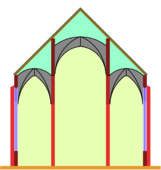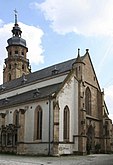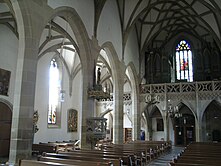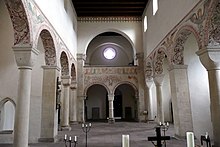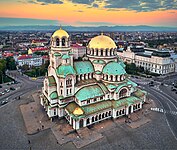Basilica
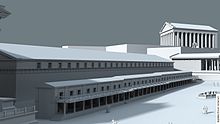


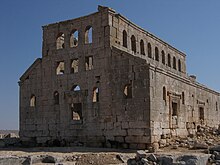
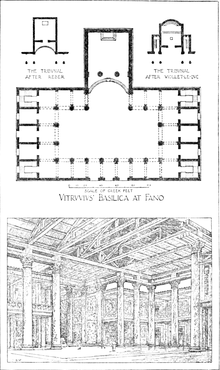
InAncient Roman architecture,abasilicawas a large public building with multiple functions that was typically built alongside the town'sforum.The basilica was in theLatin Westequivalent to astoain the Greek East. The building gave its name to thebasilicaarchitectural form.
Originally, a basilica was anancient Romanpublic building, where courts were held, as well as serving other official and public functions. Basilicas are typically rectangular buildings with a centralnaveflanked by two or more longitudinalaisles,with the roof at two levels, being higher in the centre over thenaveto admit aclerestoryand lower over the side-aisles. Anapseat one end, or less frequently at both ends or on the side, usually contained the raisedtribunaloccupied by theRoman magistrates.The basilica was centrally located in every Roman town, usually adjacent to the forum and often opposite a temple in imperial-era forums.[1]Basilicas were also built in private residences and imperial palaces and were known as "palace basilicas".
Inlate antiquity,church buildingswere typically constructed either asmartyria,or with a basilica's architectural plan. A number of monumental Christian basilicas were constructed during the latter reign ofConstantine the Great.In thepost Niceneperiod, basilicas became a standard model for Christian spaces for congregationalworshipthroughout theMediterraneanandEurope.From the early 4th century, Christian basilicas, along with their associatedcatacombs,were used forburialof the dead.
By extension, the name was later applied to Christianchurchesthat adopted the same basic plan. It continues to be used in an architectural sense to describe rectangular buildings with a centralnaveandaisles,and usually a raised platform at the end opposite the door. In Europe and the Americas, the basilica remained the most common architectural style for churches of all Christian denominations, though this building plan has become less dominant in buildings constructed since the late 20th century.
TheCatholic Churchhas come to usethe termto refer to its especially historic churches, without reference to thearchitectural form.
Origins
[edit]

The Latin wordbasilicaderives fromAncient Greek:βασιλικὴ στοά,romanized:basilikḗ stoá,lit. 'royalstoa'. The first known basilica—theBasilica Porciain theRoman Forum—was constructed in 184 BC byMarcus Porcius Cato (the Elder).[2]After the construction of Cato the Elder's basilica, the term came to be applied to any large covered hall, whether it was used for domestic purposes, was a commercial space, a military structure, or religious building.[2]
The plays ofPlautussuggest that basilica buildings may have existed prior to Cato's building. The plays were composed between 210 and 184 BC and refer to a building that might be identified with theAtrium Regium.[3]Another early example is the basilica atPompeii(late 2nd century BC). Inspiration may have come from prototypes likeAthens'sStoa Basileiosor thehypostylehall onDelos,but thearchitectural formis most derived from the audience halls in the royal palaces of theDiadochikingdoms of theHellenistic period.These rooms were typically a high nave flanked by colonnades.[3]
These basilicas were rectangular, typically with central nave and aisles, usually with a slightly raised platform and an apse at each of the two ends, adorned with a statue perhaps of the emperor, while the entrances were from the long sides.[4][5]The Romanbasilicawas a large public building where business or legal matters could be transacted.As early as the time ofAugustus,a public basilica for transacting business had been part of any settlement that considered itself a city, used in the same way as the covered market houses of late medieval northern Europe, where the meeting room, for lack of urban space, was setabovethe arcades, however.[clarify][citation needed]Although their form was variable, basilicas often contained interiorcolonnadesthat divided the space, giving aisles or arcaded spaces on one or both sides, with an apse at one end (or less often at each end), where the magistrates sat, often on a slightly raiseddais.The central aisle – the nave – tended to be wider and taller than the flanking aisles, so that light could penetrate through theclerestorywindows.[citation needed]
In the late Republican era, basilicas were increasingly monumental;Julius Caesarreplaced the Basilica Sempronia with his ownBasilica Julia,dedicated in 46 BC, while the Basilica Aemilia was rebuilt around 54 BC in so spectacular a fashion thatPliny the Elderwrote that it was among the most beautiful buildings in the world (it was simultaneously renamed theBasilica Paulli). Thereafter until the 4th century AD, monumental basilicas were routinely constructed at Rome by both private citizens and the emperors. These basilicas were reception halls and grand spaces in which élite persons could impress guests and visitors, and could be attached to a large countryvillaor an urbandomus.They were simpler and smaller than were civic basilicas, and can be identified by inscriptions or their position in the archaeological context.Domitianconstructed a basilica on thePalatine Hillfor his imperial residential complex around 92 AD, and a palatine basilica was typical in imperial palaces throughout the imperial period.[3]
Roman Republic
[edit]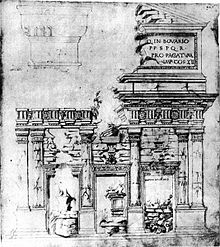
Long, rectangular basilicas with internalperistylebecame a quintessential element of Romanurbanism,often forming the architectural background to the city forum and used for diverse purposes.[6]Beginning with Cato in the early second century BC, politicians of theRoman Republiccompeted with one another by building basilicas bearing their names in theForum Romanum,the centre ofancient Rome.Outside the city, basilicas symbolised the influence of Rome and became a ubiquitous fixture of Romancoloniaeof the late Republic fromc. 100 BC.The earliest surviving basilica is the basilica ofPompeii,built 120 BC.[6]Basilicas were the administrative and commercial centres of major Roman settlements: the "quintessential architectural expression of Roman administration".[7]Adjoining it there were normally various offices and rooms housing thecuriaand a shrine for thetutela.[8]LikeRoman public baths,basilicas were commonly used as venues for the display of honorific statues and other sculptures, complementing the outdoor public spaces and thoroughfares.[9]
Beside the Basilica Porcia on theForum Romanum,theBasilica Aemiliawas built in 179 BC, and theBasilica Semproniain 169 BC.[3]In the Republic two types of basilica were built across Italy in the mid-2nd to early 1st centuries BC: either they were nearly square as atFanum Fortunae,designed byVitruvius,andCosa,with a 3:4 width-length ratio; or else they were more rectangular, as Pompeii's basilica, whose ratio is 3:7.[10][3]
The basilica atEphesusis typical of the basilicas in the Roman East, which usually have a very elongated footprint and a ratio between 1:5 and 1:9, with open porticoes facing theagora(the Hellenic forum); this design was influenced by the existing tradition of longstoaein HellenisticAsia.[3]Provinces in the west lacked this tradition, and the basilicas the Romans commissioned there were more typically Italian, with the central nave divided from the side-aisles by an internal colonnade in regular proportions.[3]


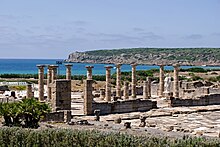


Early Empire
[edit]Beginning with theForum of Caesar(Latin:forum Iulium) at the end of the Roman Republic, the centre of Rome was embellished with a series ofimperial foratypified by a large open space surrounded by a peristyle, honorific statues of the imperial family (gens), and a basilica, often accompanied by other facilities like atemple,market hallsandpublic libraries.[6]In the imperial period, statues of the emperors with inscribed dedications were often installed near the basilicas' tribunals, as Vitruvius recommended. Examples of such dedicatory inscriptions are known from basilicas atLucus FeroniaeandVeleiain Italy and atCuiculinAfrica Proconsolaris,and inscriptions of all kinds were visible in and around basilicas.[11]
At Ephesus the basilica-stoahad two storeys and three aisles and extended the length of the civicagora's north side, complete with colossal statues of the emperor Augustus and his imperial family.[7]
The remains of a large subterraneanNeopythagoreanbasilica dating from the 1st century AD were found near thePorta Maggiorein Rome in 1917, and is known as thePorta Maggiore Basilica.[citation needed][12]
After its destruction in 60 AD,Londinium(London) was endowed with its first forum and basilica under theFlavian dynasty.[13]The basilica delimited the northern edge of the forum with typical nave, aisles, and a tribunal, but with an atypical semi-basement at the western side.[13]Unlike inGaul,basilica-forum complexes inRoman Britaindid not usually include a temple; instead a shrine was usually inside the basilica itself.[13]At Londinium however, there was probably no temple at all attached to the original basilica, but instead a contemporary temple was constructed nearby.[13]Later, in 79 AD, an inscription commemorated the completion of the 385 by 120 foot (117 m × 37 m) basilica atVerulamium(St Albans) under the governorGnaeus Julius Agricola;by contrast the first basilica at Londinium was only 148 by 75 feet (45 m × 23 m).[13]The smallest known basilica in Britain was built by theSiluresatCaerwentand measured 180 by 100 feet (55 m × 30 m).[13]
When Londinium became acolonia,the whole city was re-planned and a new great forum-basilica complex erected, larger than any in Britain.[14]Londinium's basilica, more than 500 feet (150 m) long, was the largest north of theAlpsand a similar length to the modernSt Paul's Cathedral.[14]Only the later basilica-forum complex atTreverorumwas larger, while at Rome only the 525 foot (160 m) Basilica Ulpia exceeded London's in size.[14]It probably had arcaded, rather thantrabeate,aisles, and a double row of square offices on the northern side, serving as the administrative centre of thecolonia,and its size and splendour probably indicate an imperial decision to change the administrative capital of Britannia to Londinium fromCamulodunum(Colchester), as all provincial capitals were designatedcoloniae.[14]In 300 Londinium's basilica was destroyed as a result of the rebellion led by theAugustusof the break-awayBritannic Empire,Carausius.[15]Remains of the great basilica and its arches were discovered during the construction ofLeadenhall Marketin the 1880s.[14]
AtCorinthin the 1st century AD, a new basilica was constructed in on the east side of the forum.[7]It was possibly inside the basilica thatPaul the Apostle,according to theActs of the Apostles(Acts18:12–17) was investigated and found innocent by theSuffect ConsulLucius Junius Gallio Annaeanus,the brother ofSeneca the Younger,after charges were brought against him by members of the localJewish diaspora.[7]Modern tradition instead associates the incident with an open-air inscribedbemain the forum itself.[7]
The emperorTrajanconstructed his own imperial forum in Rome accompanied by hisBasilica Ulpiadedicated in 112.[16][3]Trajan's Forum(Latin:forum Traiani) was separated from theTemple of Trajan,theUlpian Library,and his famousColumndepicting theDacian Warsby the Basilica.[16][3]It was an especially grand example whose particular symmetrical arrangement with an apse at both ends was repeated in the provinces as a characteristic form.[3]To improve the quality of theRoman concreteused in the Basilica Ulpia, volcanicscoriafrom theBay of NaplesandMount Vesuviuswere imported which, though heavier, was stronger than thepumiceavailable closer to Rome.[17]The Bailica Ulpia is probably an early example oftie barsto restrain the lateral thrust of thebarrel vaultresting on a colonnade; both tie-bars and scoria were used in contemporary work at theBaths of Trajanand later the Hadrianic domed vault of thePantheon.[17]
In early 123, theaugustaand widow of the emperor Trajan,Pompeia Plotinadied.Hadrian,successor to Trajan,deifiedher and had a basilica constructed in her honour in southernGaul.[18]
TheBasilica Hilariana(builtc. 145–155) was designed for the use of the cult ofCybele.[3]
The largest basilica built outside Rome was that built under theAntonine dynastyon theByrsahill inCarthage.[19]The basilica was built together with a forum of enormous size and was contemporary with a great complex of public baths and a new aqueduct system running for 82 miles (132 km), then the longest in the Roman Empire.[19]
The basilica atLeptis Magna,built by theSeptimius Severusa century later in about 216 is a notable 3rd century AD example of the traditional type, most notable among the works influenced by the Basilica Ulpia.[2][3]The basilica at Leptis was built mainly oflimestoneashlar,but the apses at either end were only limestone in the outer sections and built largely ofrubble masonryfaced with brick, with a number of decorative panels inopus reticulatum.[20]The basilica stood in a new forum and was accompanied by a programme of Severan works at Leptis includingthermae,a new harbour, and a public fountain.[6]AtVolubilis,principal city ofMauretania Tingitana,a basilica modelled on Leptis Magna's was completed during the short reign ofMacrinus.[21]
Basilicas in the Roman Forum
[edit]
- Basilica Porcia: first basilica built in Rome (184 BC), erected on the personal initiative and financing of the censor Marcus Porcius Cato (Cato the Elder) as an official building for thetribunes of the plebs
- Basilica Aemilia,built by the censorAemilius Lepidusin 179 BC
- Basilica Sempronia,built by the censorTiberius Sempronius Gracchusin 169 BC
- Basilica Opimia,erected probably by the consulLucius Opimiusin 121 BC, at the same time that he restored thetemple of Concord(Platner, Ashby 1929)
- Basilica Julia,initially dedicated in 46 BC byJulius Caesarand completed by Augustus 27 BC to AD 14
- Basilica Argentaria,erected underTrajan,emperor from AD 98 to 117
- Basilica of Maxentius and Constantine(built between AD 308 and 312)
Late antiquity
[edit]

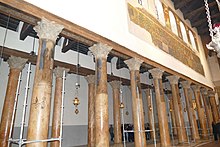

The aisled-hall plan of the basilica was adopted by a number of religious cults inlate antiquity.[2]AtSardis,amonumental basilicahoused the city'ssynagogue,serving the localJewish diaspora.[22]New religions like Christianity required space for congregational worship, and the basilica was adapted by the early Church for worship.[8]Because they were able to hold large number of people, basilicas were adopted for Christian liturgical use afterConstantine the Great.The early churches of Rome were basilicas with an apsidal tribunal and used the same construction techniques of columns and timber roofing.[2]
At the start of the 4th century at Rome there was a change in burial andfunerarypractice, moving away from earlier preferences for inhumation in cemeteries – popular from the 2nd and 3rd centuries AD – to the newer practice of burial incatacombsand inhumation inside Christian basilicas themselves.[23]Conversely, new basilicas often were erected on the site of existing early Christian cemeteries andmartyria,related to the belief inBodily Resurrection,and the cult of the sacred dead became monumentalised in basilica form.[24]Traditional civic basilicas andbouleuteriadeclined in use with the weakening of thecurial class(Latin:curiales) in the 4th and 5th centuries, while their structures were well suited to the requirements of congregational liturgies.[24]The conversion of these types of buildings into Christian basilicas was also of symbolic significance, asserting the dominance of Christianity and supplanting the old political function of public space and the city-centre with an emphatic Christian social statement.[24]Traditional monumental civic amenities likegymnasia,palaestrae,andthermaewere also falling into disuse, and became favoured sites for the construction of new churches, including basilicas.[24]
Under Constantine, the basilica became the most prestigious style of church building, was "normative" for church buildings by the end of the 4th century, and were ubiquitous in western Asia, North Africa, and most of Europe by the close of the 7th century.[25]Christians also continued to hold services in synagogues, houses, and gardens, and continued practisingbaptismin rivers, ponds, and Roman bathhouses.[25][26]
The development of Christian basilicas began even before Constantine's reign: a 3rd-centurymud-brickhouse atAqabahad become a Christian church and was rebuilt as a basilica.[25]Within was a rectangular assembly hall withfrescoesand at the east end anambo,acathedra,and an altar.[25]Also within the church were a catecumenon (forcatechumens), a baptistery, adiaconicon,and aprothesis:all features typical of later 4th century basilica churches.[25]A Christian structure which included the prototype of the triumphal arch at the east end of later Constantinian basilicas.[25]Known as theMegiddo church,it was built at Kefar 'Othnay inPalestine,possibly c. 230, for or by theRoman armystationed atLegio(laterLajjun).[25]Its dedicatory inscriptions include the names of women who contributed to the building and were its major patrons, as well as men's names.[25]A number of buildings previously believed to have been Constantinian or 4th century have been reassessed as dating to later periods, and certain examples of 4th century basilicas are not distributed throughout the Mediterranean world at all evenly.[27]Christian basilicas andmartyriaattributable to the 4th century are rare on the Greek mainland and on theCyclades,while the Christian basilicas of Egypt,Cyprus,Syria,Transjordan,Hispania,andGaulare nearly all of later date.[27]The basilica at Ephesus'sMagnesian Gate,the episcopal church atLaodicea on the Lycus,and two extramural churches atSardishave all been considered 4th century constructions, but on weak evidence.[24]Development ofpottery chronologiesfor Late Antiquity had helped resolve questions of dating basilicas of the period.[28]
Three examples of abasilica discopertaor "hypaethralbasilica "with no roof above the nave are inferred to have existed.[29]The 6th centuryAnonymous pilgrim of Piacenzadescribed a "basilica built with aquadriporticus,with the middle atrium uncovered "atHebron,while atPécsand nearSalonatwo ruined 5th buildings of debated interpretation might have been either roofless basilica churches or simply courtyards with anexedraat the end.[29]An old theory byEjnar Dyggvethat these were the architectural intermediary between the Christianmartyriumand the classicalheröonis no longer credited.[29]
The magnificence of early Christian basilicas reflected the patronage of the emperor and recalled his imperial palaces and reflected the royal associations of the basilica with theHellenistic Kingdomsand even earlier monarchies like that ofPharaonic Egypt.[25]Similarly, the name and association resounded with the Christian claims of the royalty ofChrist– according to theActs of the Apostlesthe earliest Christians had gathered at the royalStoaof Solomon inJerusalemto assert Jesus's royal heritage.[25]For early Christians, theBiblesupplied evidence that theFirst TempleandSolomon's palacewere bothhypostylehalls and somewhat resembled basilicas.[25]Hypostyle synagogues, often built with apses in Palestine by the 6th century, share a common origin with the Christian basilicas in the civic basilicas and in the pre-Roman style of hypostyle halls in the Mediterranean Basin, particularly in Egypt, where pre-classical hypostyles continued to be built in the imperial period and were themselves converted into churches in the 6th century.[25]Other influences on the evolution of Christian basilicas may have come from elements of domestic and palatial architecture during the pre-Constantinian period of Christianity, including the reception hall oraula(Ancient Greek:αὐλή,romanized:aulḗ,lit. 'courtyard') and theatriaandtricliniaof élite Roman dwellings.[25]The versatility of the basilica form and its variability in size and ornament recommended itself to the earlyChristian Church:basilicas could be grandiose as the Basilica of Maxentius in theForum Romanumor more practical like the so-called Basilica ofBahirainBosra,while theBasilica Constantinianaon theLateran Hillwas of intermediate scale.[25]This basilica, begun in 313, was the first imperial Christian basilica.[25]Imperial basilicas were first constructed for the ChristianEucharistliturgyin the reign of Constantine.[26]
Basilica churches were not economically inactive. Like non-Christian or civic basilicas, basilica churches had a commercial function integral to their local trade routes and economies.Amphoraediscovered at basilicas attest their economic uses and can reveal their position in wider networks of exchange.[28]AtDionnearMount OlympusinMacedonia,now anArchaeological Park,the latter 5th centuryCemetery Basilica,a small church, was replete withpotsherdsfrom all over theMediterranean,evidencing extensive economic activity took place there.[28][30]Likewise atMaroni Petreraon Cyprus, the amphorae unearthed by archaeologists in the 5th century basilica church had been imported from North Africa, Egypt,Palestine,and theAegean basin,as well as from neighbouringAsia Minor.[28][31]
According toVegetius,writing c. 390, basilicas were convenient fordrillingsoldiers of theLate Roman armyduring inclement weather.[3]
Basilica of Maxentius
[edit]
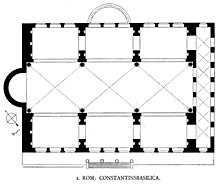

The 4th centuryBasilica of Maxentius,begun byMaxentiusbetween 306 and 312 and according toAurelius Victor'sDe Caesaribuscompleted by Constantine I, was an innovation.[32][33]Earlier basilicas had mostly had wooden roofs, but this basilica dispensed with timber trusses and used insteadcross-vaultsmade fromRoman bricksandconcreteto create one of the ancient world's largest covered spaces: 80 m long, 25 m wide, and 35 m high.[3][32]Theverticesof the cross-vaults, the largest Roman examples, were 35 m.[32]The vault was supported onmarblemonolithic columns 14.5 m tall.[32]The foundations are as much as 8 m deep.[17]The vault was supported by brick latticework ribs (Latin:bipedalis) forming lattice ribbing, an early form ofrib vault,and distributing the load evenly across the vault's span.[17]Similar brick ribs were employed at theBaths of Maxentiuson thePalatine Hill,where they supported walls on top of the vault.[17]Also known as theBasilica Constantiniana,'Basilica of Constantine' orBasilica Nova,'New Basilica', it chanced to be the last civic basilica built in Rome.[3][32]
Inside the basilica the central nave was accessed by five doors opening from an entrance hall on the eastern side and terminated in an apse at the western end.[32]Another, shallower apse with niches for statues was added to the centre of the north wall in a second campaign of building, while the western apse housed a colossalacrolithicstatue of the emperor Constantine enthroned.[32]Fragments of this statue are now in the courtyard of the Palazzo dei Conservatori on theCapitoline Hill,part of theCapitoline Museums.Opposite the northern apse on the southern wall, another monumental entrance was added and elaborated with aporticoofporphyrycolumns.[32]One of the remaining marble interior columns was removed in 1613 byPope Paul Vand set up as an honorific column outsideSanta Maria Maggiore.[32]
Constantinian period
[edit]
In the early 4th centuryEusebiusused the word basilica (Ancient Greek:βασιλική,romanized:basilikḗ) to refer to Christian churches; in subsequent centuries as before, the word basilica referred in Greek to the civic, non-ecclesiastical buildings, and only in rare exceptions to churches.[34]Churches were nonetheless basilican in form, with an apse or tribunal at the end of a nave with two or more aisles typical.[34]Anarthex(sometimes with an exonarthex) orvestibulecould be added to the entrance, together with anatrium,and the interior might havetransepts,apastophorion,andgalleries,but the basic scheme with clerestory windows and a woodentruss roofremained the most typical church type until the 6th century.[34]The nave would be kept clear for liturgical processions by the clergy, with thelaityin the galleries and aisles to either side.[34]The function of Christian churches was similar to that of the civic basilicas but very different from temples in contemporaryGraeco-Roman polytheism:while pagan temples were entered mainly by priests and thus had their splendour visible from without, within Christian basilicas the main ornamentation was visible to the congregants admitted inside.[25]Christian priests did not interact with attendees during the rituals which took place at determined intervals, whereas pagan priests were required to perform individuals' sacrifices in the more chaotic environment of the temple precinct, with the temple's facade as backdrop.[25]In basilicas constructed for Christian uses, the interior was often decorated withfrescoes,but these buildings' wooden roof often decayed and failed to preserve the fragile frescoes within.[27]Thus was lost an important part of the early history ofChristian art,which would have sought to communicate early Christian ideas to the mainly illiterate Late Antique society.[27]On the exterior, basilica church complexes included cemeteries, baptisteries, andfontswhich "defined ritual and liturgical access to the sacred", elevated the social status of the Church hierarchy, and which complemented the development of a Christian historical landscape; Constantine and his motherHelenawere patrons of basilicas in important Christian sites in theHoly Landand Rome, and at Milan and Constantinople.[27]
Around 310, while still a self-proclaimedaugustusunrecognised at Rome, Constantine began the construction of theBasilica ConstantinianaorAula Palatina,'palatine hall', as a reception hall for his imperial seat atTrier(Augusta Treverorum), capital ofBelgica Prima.[3]On the exterior, Constantine's palatine basilica was plain and utilitarian, but inside was very grandly decorated.[35]
In the reign of Constantine I, a basilica was constructed for thePopein theformer barracksof theEquites singulares Augusti,thecavalryarm of thePraetorian Guard.[36](Constantine had disbanded the Praetorian guard after his defeat of their emperor Maxentius and replaced them with another bodyguard, theScholae Palatinae.)[36]In 313 Constantine began construction of theBasilica Constantinianaon the Lateran Hill.[25]This basilica became Rome'scathedralchurch, known asSt John Lateran,and was more richly decorated and larger than any previous Christian structure.[25]However, because of its remote position from theForum Romanumon the city's edge, it did not connect with the older imperial basilicas in the fora of Rome.[25]Outside the basilica was theEquestrian Statue of Marcus Aurelius,a rare example of an Antique statue that has never been underground.[9]
According to theLiber Pontificalis,Constantine was also responsible for the rich interior decoration of theLateran Baptisteryconstructed underPope Sylvester I(r. 314–335), sited about 50 metres (160 ft).[26]The Lateran Baptistery was the first monumental free-standing baptistery, and in subsequent centuries Christian basilica churches were often endowed with such baptisteries.[26]
AtCirta,a Christian basilica erected by Constantine was taken over by his opponents, theDonatists.[36]After Constantine's failure to resolve the Donatist controversy by coercion between 317 and 321, he allowed the Donatists, who dominatedAfrica,to retain the basilica and constructed a new one for theCatholic Church.[36]
The originaltitular churchesof Rome were those which had been private residences and which were donated to be converted to places of Christian worship.[25]Above an originally 1st century AD villa and its later adjoiningwarehouseandMithraeum,a large basilica church had been erected by 350, subsuming the earlier structures beneath it as a crypt.[25]The basilica was the first church ofSan Clemente al Laterano.[25]Similarly, atSanti Giovanni e Paolo al Celio,an entire ancientcity block– a 2nd-centuryinsulaon theCaelian Hill– was buried beneath a 4th-century basilica.[25]The site was already venerated as themartyriumof three early Christian burials beforehand, and part of theinsulahad been decorated in the style favoured by Christian communities frequenting the earlyCatacombs of Rome.[25]
By 350 inSerdica(Sofia,Bulgaria), a monumental basilica – theChurch of Saint Sophia– was erected, covering earlier structures including a Christian chapel, an oratory, and a cemetery dated to c. 310.[25]Other major basilica from this period, in this part of Europe, is theGreat BasilicainPhilippopolis(Plovdiv,Bulgaria) from the 4th century AD.
Valentinianic–Theodosian period
[edit]In the late 4th century the dispute betweenNiceneandArian Christianitycame to head atMediolanum(Milan), whereAmbrosewas bishop.[37]AtEasterin 386 theArianparty, preferred by theTheodosian dynasty,sought to wrest the use of the basilica from the Nicene partisan Ambrose.[37]According toAugustine of Hippo,the dispute resulted in Ambrose organising an 'orthodox'sit-inat the basilica and arranged the miraculous invention and translation ofmartyrs,whose hidden remains had been revealed in avision.[37]During the sit-in, Augustine credits Ambrose with the introduction from the "eastern regions" ofantiphonalchanting, to give heart to the orthodox congregation, though in fact music was likely part of Christian ritual since the time of thePauline epistles.[38][37]The arrival and reburial of the martyrs' uncorrupted remains in the basilica in time for the Easter celebrations was seen as powerful step towards divine approval.[37]
AtPhilippi,the market adjoining the 1st-century forum was demolished and replaced with a Christian basilica.[7]Civic basilicas throughout Asia Minor became Christian places of worship; examples are known at Ephesus,Aspendos,and atMagnesia on the Maeander.[24]TheGreat BasilicainAntioch of Pisidiais a rare securely dated 4th century Christian basilica and was the city's cathedral church.[24]The mosaics of the floor credit Optimus, the bishop, with its dedication.[24]Optimus was a contemporary ofBasil of Caesareaand corresponded with him c. 377.[24]Optimus was the city's delegate at theFirst Council of Constantinoplein 381, so the 70 m-long single-apsed basilica near the city walls must have been constructed around that time.[24]Pisidiahad a number of Christian basilicas constructed in Late Antiquity, particularly in formerbouleuteria,as atSagalassos,Selge,Pednelissus,while a civic basilica was converted for Christians' use inCremna.[24]
AtChalcedon,opposite Constantinople on the Bosporus, the relics ofEuphemia– a supposed Christian martyr of the Diocletianic Persecution – were housed in amartyriumaccompanied by a basilica.[39]The basilica already existed whenEgeriapassed through Chalcedon in 384, and in 436Melania the Youngervisited the church on her own journey to the Holy Land.[39]From the description ofEvagrius Scholasticusthe church is identifiable as an aisled basilica attached to themartyriumand preceded by anatrium.[40]TheCouncil of Chalcedon(8–31 October 451) was held in the basilica, which must have been large enough to accommodate the more than two hundred bishops that attended its third session, together with their translators and servants; around 350 bishops attended the Council in all.[41][42]In anekphrasisin his eleventhsermon,Asterius of Amaseadescribed an icon in the church depicting Euphemia's martyrdom.[39]The church was restored under the patronage of thepatriciaand daughter ofOlybrius,Anicia Juliana.[43]Pope Vigiliusfled there from Constantinople during theThree-Chapter Controversy.[44]The basilica, which lay outside the walls of Chalcedon, was destroyed by the Persians in theByzantine–Sasanian War of 602–628during one of the Sasanian occupations of the city in 615 and 626.[45]The relics of Euphemia were reportedlytranslatedto a newChurch of St Euphemiain Constantinople in 680, thoughCyril Mangoargued the translation never took place.[46][47]Subsequently, Asterius's sermonOn the Martyrdom of St Euphemiawas advanced as an argument foriconodulismat theSecond Council of Nicaeain 787.[48]
In the late 4th century, a large basilica church dedicated toMary, mother of Jesuswas constructed inEphesusin the former southstoa(a commercial basilica) of the Temple of HadrianOlympios.[49][50]Ephesus was the centre of the Roman province ofAsia,and was the site of the city's famedTemple of Artemis,one of the Seven Wonders of the Ancient World.[51]It had also been a centre of theRoman imperial cultin Asia; Ephesus was three times declaredneokoros(lit. 'temple-warden') and had constructed aTemple of the Sebastoito theFlavian dynasty.[51]The Basilica of the Virgin Mary was probably the venue for the 431Council of Ephesusand the 449Second Council of Ephesus,both convened byTheodosius II.[49]At some point during the Christianisation of the Roman world, Christian crosses were cut into the faces of the colossal statues ofAugustusandLiviathat stood in the basilica-stoaof Ephesus; the crosses were perhaps intended toexorcisedemonsin a process akin to baptism.[9]In the eastern cemetery ofHierapolisthe 5th century domed octagonalmartyriumofPhilip the Apostlewas built alongside a basilica church, while atMyratheBasilica of St Nicholaswas constructed at the tomb ofSaint Nicholas.[24]
AtConstantinoplethe earliest basilica churches, like the 5th century basilica at theMonastery of Stoudios,were mostly equipped with a small cruciform crypt (Ancient Greek:κρυπτή,romanized:kryptḗ,lit. 'hidden'), a space under the church floor beneath the altar.[52]Typically, these crypts were accessed from the apse's interior, though not always, as at the 6th century Church of St John at theHebdomon,where access was from outside the apse.[52]At Thessaloniki, theRoman bathwhere tradition heldDemetrius of Thessalonikihad been martyred was subsumed beneath the 5th century basilica ofHagios Demetrios,forming a crypt.[52]
The largest and oldest basilica churches in Egypt were atPbow,acoenobiticmonastery established byPachomius the Greatin 330.[53]The 4th century basilica was replaced by a large 5th century building (36 × 72 m) with five aisles and internal colonnades of pink granite columns and paved with limestone.[53]This monastery was the administrative centre of the Pachomian order where the monks would gather twice annually and whose library may have produced many survivingmanuscriptsof biblical, Gnostic, and other texts in Greek andCoptic.[53]InNorth Africa,late antique basilicas were often built on a doubled plan.[54]In the 5th century, basilicas with two apses, multiple aisles, and doubled churches were common, including examples respectively atSufetula,Tipasa,andDjémila.[54]Generally, North African basilica churches'altarswere in the nave and the main building medium wasopus africanumof local stone, andspoliawas infrequently used.[54]
The Church of the East'sCouncil of Seleucia-Ctesiphonwas convened by theSasanian EmperorYazdegerd Iat his capital atCtesiphon;according toSynodicon Orientale,the emperor ordered that the former churches in theSasanian Empireto be restored and rebuilt, that such clerics andasceticsas had been imprisoned were to be released, and theirNestorian Christiancommunities allowed to circulate freely and practice openly.[55]
In easternSyria,theChurch of the Eastdeveloped at typical pattern of basilica churches.[55]Separate entrances for men and women were installed in the southern or northern wall; within, the east end of the nave was reserved for men, while women and children were stood behind. In the nave was abema,from whichScripturecould be read, and which were inspired by the equivalent in synagogues and regularised by theChurch of Antioch.[55]The Council of 410 stipulated that onSundaythearchdeaconwould read theGospelsfrom thebema.[55]Standing near thebema,thelay folkcould chant responses to the reading and if positioned near thešqāqonā( "a walled floor-level pathway connecting thebemato the altar area ") could try to kiss or touch theGospel Bookas it was processed from thedeacons' room to thebemaand thence to thealtar.[55]Some ten Eastern churches in eastern Syria have been investigated by thorougharchaeology.[55]
A Christian basilica was constructed in the first half of the 5th century atOlympia,where thestatue of ZeusbyPhidiashad been noted as one of theSeven Wonders of the Ancient Worldever since the 2nd century BC list compiled byAntipater of Sidon.[56][57]Cultural tourism thrived at Olympia andAncient Greek religioncontinued to be practised there well into the 4th century.[56]AtNicopolisinEpirus,founded byAugustusto commemorate his victory at theBattle of Actiumat the end of theLast war of the Roman Republic,four early Christian basilicas were built during Late Antiquity whose remains survive to the present.[58]In the 4th or 5th century, Nicopolis was surrounded by a new city wall.[58]
InBulgariathere are major basilicas from that time likeElenska Basilicaand theRed Church.
-
Santa Sabina,Rome, 422–432.
-
Basilica church of theMonastery of Stoudios,Constantinple, 5th century, as depicted in theMenologion of Basil II,c. 1000.
-
Apse of the ruinedGreat Basilica,Antioch in Pisidia. The floor dates to late 4th century, and the walls to the 5th or 6th century. The building has a semi-circular interior and a polygonal exterior.
-
Bird's eye view of theElenska Basilicacomplex,Pirdop,Bulgaria.
-
TheRed Church,Perushtitsa,Bulgaria.
Leonid period
[edit]OnCrete,the Roman cities suffered from repeated earthquakes in the 4th century, but between c. 450 and c. 550, a large number of Christian basilicas were constructed.[59]Crete was throughout Late Antiquity aprovinceof theDiocese of Macedonia,governed from Thessaloniki.[59]
Nine basilica churches were built atNea Anchialos,ancientPhthiotic Thebes(Ancient Greek:Θη̑βαι Φθιώτιδες,romanized:Τhḗbai Phthiṓtides), which was in its heyday the primary port ofThessaly.Theepiscopal seewas the three-aisledBasilica A,theChurchof StDemetrius of Thessaloniki,and similar to theChurch of the AcheiropoietosinThessaloniki.[60]Its atrium perhaps had a pair of towers to either side and its construction dates to the late 5th/early 6th century.[60]The Elpidios Basilica –Basilica B– was of similar age, and the city was home to a large complex of ecclesiastical buildings includingBasilica G,with its luxurious mosaic floors and a mid-6th century inscription proclaiming the patronage of the bishop Peter. Outside thedefensive wallwasBasilica D,a 7th-century cemetery church.[60]
Stobi,(Ancient Greek:Στόβοι,romanized:Stóboi) the capital from the late 4th century of the province ofMacedonia II Salutaris,had numerous basilicas and six palaces in late antiquity.[61]TheOld Basilicahad two phases of geometric pavements, the second phase of which credited the bishop Eustathios as patron of the renovations. A newer episcopal basilica was built by the bishop Philip atop the remains of the earlier structure, and two further basilicas were within the walls.[61]TheCentral Basilicareplaced asynagogueon a site razed in the late 5th century, and there was also aNorth Basilicaand further basilicas without the walls.[61]Various mosaics and sculptural decorations have been found there, and while the city suffered from theOstrogothsin 479 and an earthquake in 518, ceasing to be a major city thereafter, it remained a bishopric until the end of the 7th century and theBasilica of Philiphad itstemplonrestored in the 8th century.[61]
TheSmall BasilicaofPhilippopolis(Plovdiv, Bulgaria) inThracewas built in the second half of the 5th century AD.
-
Drawing of the 5th centuryChurch of the AcheiropoietosbyCharles Texier,1864
-
LeonidbasilicaChurch of the Acheiropoietos,Thessaloniki, 450–60
-
5th-century mosaic of a basilica (Louvre)
Justinianic period
[edit]Justinian Iconstructed at Ephesus a large basilica church, theBasilica of St John,above the supposed tomb ofJohn the Apostle.[51]The church was a domed cruciform basilica begun in 535/6; enormous and lavishly decorated, it was built in the same style as Justinian'sChurch of the Holy Apostlesin Constantinople.[49][24]The Justinianic basilica replaced an earlier, smaller structure whichEgeriahad planned to visit in the 4th century, and remains of a 2,130 foot (650 m) aqueduct branch built to supply the complex with water probably dates from Justinian's reign.[49][62]The Ephesians' basilicas to St Mary and St John were both equipped withbaptisterieswith filling and draining pipes: bothfontswere flush with the floor and unsuitable forinfant baptism.[26]As with most Justinianic baptisteries in theBalkansandAsia Minor,the baptistery at the Basilica of St John was on the northern side of the basilica's nave; the 734 m2baptistery was separated from the basilica by a 3 m-wide corridor.[26]According to the 6th centurySyriacwriterJohn of Ephesus,aSyriac OrthodoxChristian, theheterodoxMiaphysitesheldordinationservices in the courtyard of the Basilica of St John under cover of night.[49]Somewhat outside the ancient city on thehill of Selçuk,the Justinianic basilica became the centre of the city after the 7th centuryArab–Byzantine wars.[49]
At Constantinople, Justinian constructed the largest domed basilica: on the site of the 4th century basilica Church ofHoly Wisdom,the emperor ordered construction of the huge domed basilica that survives to the present: theHagia Sophia.[27]This basilica, which "continues to stand as one of the most visually imposing and architecturally daring churches in the Mediterranean", was the cathedral of Constantinople and the patriarchal church of thePatriarch of Constantinople.[27]Hagia Sophia, originally founded by Constantine, was at the social and political heart of Constantinople, near to theGreat Palace,theBaths of Zeuxippus,and theHippodrome of Constantinople,while the headquarters of theEcumenical Patriarchatewas within the basilica's immediate vicinity.[63]
The mid-6th century Bishop ofPoreč(Latin:ParensorParentium;Ancient Greek:Πάρενθος,romanized:Párenthos) replaced an earlier 4th century basilica with the magnificent Euphrasian Basilica in the style of contemporary basilicas atRavenna.[64]Some columncapitalswere of marble from Greece identical to those inBasilica of San Vitaleand must have been imported from the Byzantine centre along with the columns and some of theopus sectile.[64]There areconchmosaics in the basilica's three apses and the fineopus sectileon the central apse wall is "exceptionally well preserved".[64]
The 4th century basilica ofSaint Sophia Churchat Serdica (Sofia, Bulgaria) was rebuilt in the 5th century and ultimately replaced by a new monumental basilica in the late 6th century, and some construction phases continued into the 8th century.[65]This basilica was the cathedral of Serdica and was one of three basilicas known to lie outside the walls; three more churches were within the walled city, of which theChurch of Saint Georgewas a former Roman bath built in the 4th century, and another was a former Mithraeum.[65]The basilicas were associated with cemeteries with Christian inscriptions and burials.[65]
Another basilica from this period in Bulgaria was theBelovo Basilica(6th century AD).
TheMiaphysiteconvert from theChurch of the East,Ahudemmehconstructed a new basilicac. 565dedicated toSaint SergiusatʿAin Qenoye (orʿAin Qena according toBar Hebraeus) after being ordained bishop ofBeth ArbayebyJacob Baradaeusand while proselytizing among theBedouinofArbayistanin the Sasanian Empire.[66]According to Ahudemmeh's biographer this basilica and itsmartyrium,in the upperTigrisvalley, was supposed to be a copy of the Basilica of St Sergius at Sergiopolis (Resafa), in the middleEuphrates,so that the Arabs would not have to travel so far on pilgrimage.[66]More likely, with the support ofKhosrow Ifor its construction and defence against theNestorianswho wereMiaphysites' rivals, the basilica was part of an attempt to control the frontier tribes and limit their contact with the Roman territory of Justinian, who had agreed in the 562Fifty-Year Peace Treatyto pay 30,000nomismataannually to Khosrow in return for a demilitarization of the frontier after the latest phase of theRoman–Persian Wars.[66]After being mentioned in 828 and 936, the basilica atʿAin Qenoye disappeared from recorded history, though it may have remained occupied for centuries, and was rediscovered as a ruin byCarsten Niebuhrin 1766.[67]The name of the modern site Qasr Serīj is derived from the basilica's dedication to St Sergius.[66]Qasr Serīj's construction may have been part of the policy of toleration that Khosrow and his successors had for Miaphysitism – a contrast with Justinian's persecution of heterodoxy within the Roman empire.[66]This policy itself encouraged many tribes to favour the Persian cause, especially after the death in 569 of theGhassanid Kingdom's Miaphysite kingal-Harith ibn Jabalah(Latin:Flavius Arethas,Ancient Greek:Ἀρέθας) and the 584 suppression by the Romans of his successors' dynasty.[66]
-
Saint Sophia,Serdica (Sofia), built 4th–8th centuries
-
OstrogothicBasilica of Christ the Redeemer,Ravenna, 504.Rededicated 561 to St Apollinaris
-
JustinianicChurch of the Nativity,Bethlehem, after 529
-
Floor plan of the JustinianicBasilica of St John,Ephesus, after 535/6
-
Ruins of the 10th-century Church ofAchillius of Larissa,on the eponymous island ofAgios Achilleios, Mikra Prespa,a typical basilica church[68]
-
Belovo Basilica,Belovo Municipality,Bulgaria
Palace basilicas
[edit]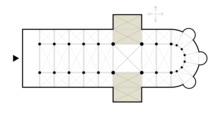
In theRoman Imperial period(after about 27 BC), a basilica for large audiences also became a feature in palaces. In the 3rd century of the Christian era, the governing elite appeared less frequently in the forums.
They now tended to dominate their cities from opulent palaces and country villas, set a little apart from traditional centers of public life. Rather than retreats from public life, however, these residences were the forum made private.
- — Peter Brown, in Paul Veyne, 1987
Seated in thetribuneof his basilica, the great man would meet his dependentclientesearly every morning.
Constantine's basilica atTrier,theAula Palatina(AD 306), is still standing. A private basilica excavated atBulla Regia(Tunisia), in the "House of the Hunt", dates from the first half of the 5th century. Its reception or audience hall is a long rectangular nave-like space, flanked by dependent rooms that mostly also open into one another, ending in a semi-circular apse, with matchingtranseptspaces. Clustered columns emphasised the "crossing" of the two axes.
Christian adoption of the basilica form
[edit]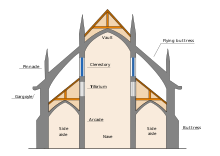
Variations: Where the roofs have a low slope, thetriforiumgallery may have own windows or may be missing.
In the 4th century, once the Imperial authorities had decriminalised Christianity with the 313Edict of Milan,and with the activities ofConstantine the Greatand his motherHelena,Christians were prepared to build larger and more handsome edifices for worship than the furtive meeting-places (such as theCenacle,cave-churches,house churchessuch asthat of the martyrs John and Paul) they had been using. Architectural formulas for temples were unsuitable due to their pagan associations, and because pagan cult ceremonies and sacrifices occurred outdoors under the open sky in the sight of the gods, with the temple, housing the cult figures and the treasury, as a backdrop. The usable model at hand, when Constantine wanted to memorialise his imperial piety, was the familiar conventional architecture of the basilicas.[69]
There were several variations of the basic plan of the secular basilica, always some kind of rectangular hall, but the one usually followed for churches had a central nave with one aisle at each side and an apse at one end opposite to the main door at the other end. In (and often also in front of) the apse was a raised platform, where the altar was placed, and from where the clergy officiated. In secular building this plan was more typically used for the smaller audience halls of the emperors, governors, and the very rich than for the great public basilicas functioning as law courts and other public purposes.[70]Constantine built a basilica of this type in his palace complex at Trier, later very easily adopted for use as a church. It is a long rectangle two storeys high, with ranks of arch-headed windows one above the other, without aisles (there was no mercantile exchange in this imperial basilica) and, at the far end beyond a huge arch, the apse in which Constantine held state.
- Comparison of cross sections of churches
-
Basilica:The central nave extends to one or two storeys more than the lateral aisles, and it has upper windows.
-
Pseudo-basilica(i. e.false basilica): The central nave extends to an additional storey, but it has no upper windows.
-
Stepped hall: The vaults of the central nave begin a bit higher than those of the lateral aisles, but there is no additional storey.
-
Hall church:All vaults are almost on the same level.
Development
[edit]Putting analtarinstead of the throne, as was done at Trier, made a church. Basilicas of this type were built in western Europe, Greece, Syria, Egypt, and Palestine, that is, at anyearly centre of Christianity.Good early examples of the architectural basilica include theChurch of the NativityatBethlehem(6th century), the church of St Elias atThessalonica(5th century), and the two great basilicas atRavenna.
The first basilicas with transepts were built under the orders ofEmperor Constantine,both in Rome and in his "New Rome",Constantinople:
Around 380,Gregory Nazianzen,describing the ConstantinianChurch of the Holy Apostlesat Constantinople, was the first to point out its resemblance to a cross. Because thecult of the crosswas spreading at about the same time, this comparison met with stunning success.
- —Yvon Thébert,in Veyne, 1987
Thus, a Christian symbolic theme was applied quite naturally to a form borrowed from civil semi-public precedents. The first great Imperially sponsored Christian basilica is that ofSt John Lateran,which was given to the Bishop of Rome by Constantine right before or around the Edict of Milan in 313 and was consecrated in the year 324. In the later 4th century, other Christian basilicas were built in Rome:Santa Sabina,andSt Paul's Outside the Walls(4th century), and laterSt Clement(6th century).
A Christian basilica of the 4th or 5th century stood behind its entirely enclosedforecourtringed with a colonnade or arcade, like the stoa orperistylethat was its ancestor or like thecloisterthat was its descendant. This forecourt was entered from outside through a range of buildings along the public street. This was the architectural ground-plan ofSt. Peter's Basilicain Rome, until in the 15th century it was demolished to make way for a modern church built to a new plan.
In most basilicas, the central nave is taller than the aisles, forming a row of windows called a clerestory. Some basilicas in theCaucasus,particularly those ofArmeniaandGeorgia,have a central nave only slightly higher than the two aisles and a single pitched roof covering all three. The result is a much darker interior. This plan is known as the "oriental basilica", or "pseudobasilica" in central Europe. A peculiar type of basilica, known asthree-church basilica,was developed in early medieval Georgia, characterised by the central nave which is completely separated from the aisles with solid walls.[71]
Gradually, in theEarly Middle Agesthere emerged the massiveRomanesquechurches, which still kept the fundamental plan of the basilica.
InMedieval BulgariatheGreat Basilicawas finished around 875. The architectural complex inPliska,the first capital of theFirst Bulgarian Empire,included acathedral,anarchbishop's palace and a monastery.[72]The basilica was one of the greatestChristiancathedralsin Europe of the time, with an area of 2,920 square metres (31,400 sq ft). The still in useChurch of Saint SophiainOhridis another example from Medieval Bulgaria.
InRomania,the word for church both as a building and as an institution isbiserică,derived from the term basilica.
In theUnited Statesthe style was copied with variances. An American church built imitating the architecture of an Early Christian basilica,St. Mary's (German) ChurchinPennsylvania,was demolished in 1997.
-
Old St Peter's, Rome,as the 4th-century basilica had developed by the mid-15th century, in a 19th-century reconstruction
-
St John in the Lateranis both an architectural and an ecclesiastical basilica.
-
St. Sebald'sinNuremberghas a basilical nave and a hall choir.
-
Palma CathedralonMallorcainSpainhas windows on three levels, one above the aisles, one above the file of chapels and one in the chapels.
-
A rare American church built imitating the architecture of an Early Christian basilica,St. Mary's (German) ChurchinPennsylvania,now demolished
Catholic basilicas
[edit]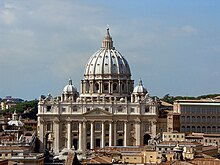
In theCatholic Church,a basilica is a church with special privileges. It is typically housed in a large and importantbuilding.This designation may be made by thePopeor may date from time immemorial.[73][74]Basilica churches are distinguished for ceremonial purposes from other churches. The building does not need to be a basilica in the architectural sense. Basilicas are either major basilicas – of which there are four, all in thediocese of Rome—or minor basilicas, of which there were 1,810 worldwide as of 2019[update].[75]TheUmbraculumis displayed in a basilica to the right side (i.e. the Epistle side) of thealtarto indicate that the church has been awarded the rank of a basilica.
See also
[edit]- Macellum– Roman covered market
- Market hall– modern covered market
- Courthouse
- Curia
- Municipal curiae
- Town hall
Architecture
[edit]References
[edit]Citations
[edit]- ^Henig, Martin (ed.),A Handbook of Roman Art,Phaidon, p. 55, 1983,ISBN0714822140;Sear, F. B., "Architecture, 1, a) Religious", section in Diane Favro, et al. "Rome, ancient." Grove Art Online.Oxford Art Online.Oxford University Press. Retrieved 26 March 2016,subscription required
- ^abcdeRoberts, John, ed. (2007),"basilica",The Oxford Dictionary of the Classical World,Oxford University Press,doi:10.1093/acref/9780192801463.001.0001,ISBN978-0-19-280146-3
- ^abcdefghijklmnopDumser, Elisha Ann (2010),"Basilica",in Gagarin, Michael (ed.),The Oxford Encyclopedia of Ancient Greece and Rome,Oxford University Press,doi:10.1093/acref/9780195170726.001.0001,ISBN978-0-19-517072-6
- ^The Oxford Dictionary of Christian Art and Architecture(2013ISBN978-0-19968027-6), p. 117
- ^"The Institute for Sacred Architecture – Articles – The Eschatological Dimension of Church Architecture".sacredarchitecture.org.
- ^abcdDonati, Jamieson C. (4 November 2014), Marconi, Clemente (ed.),"The City in the Greek and Roman World",The Oxford Handbook of Greek and Roman Art and Architecture(online ed.), Oxford University Press,doi:10.1093/oxfordhb/9780199783304.013.011,ISBN978-0-19-978330-4
- ^abcdefDavis, Thomas W. (2019), Caraher, William R.; Davis, Thomas W.; Pettegrew, David K. (eds.),"New Testament Archaeology Beyond the Gospels",The Oxford Handbook of Early Christian Archaeology,Oxford University Press, pp. 45–63,doi:10.1093/oxfordhb/9780199369041.013.34,ISBN978-0-19-936904-1
- ^abDarvill, Timothy (2009),"basilica",The Concise Oxford Dictionary of Archaeology,Oxford University Press,doi:10.1093/acref/9780199534043.001.0001,ISBN978-0-19-953404-3
- ^abcdKristensen, Troels Myrup (2019), Caraher, William R.; Davis, Thomas W.; Pettegrew, David K. (eds.),"Statues",The Oxford Handbook of Early Christian Archaeology,Oxford University Press, pp. 332–349,doi:10.1093/oxfordhb/9780199369041.013.19,ISBN978-0-19-936904-1
- ^Vitruvius,De architectura,V:1.6–10
- ^Hurlet, Frédéric (6 January 2015). Bruun, Christer; Edmondson, Jonathan (eds.).The Roman Emperor and the Imperial Family.Vol. 1 (online ed.). Oxford University Press. pp. 178–201.doi:10.1093/oxfordhb/9780195336467.013.010.ISBN978-0-19-533646-7.
{{cite book}}:|work=ignored (help) - ^Bagnani, Gilbert (1919).""The Subterranean Basilica at Porta Maggiore."".The Journal of Roman Studies.9:78–85.doi:10.2307/295990.JSTOR295990.S2CID163868898– via JSTOR.
- ^abcdefMerrifield, Ralph (1983).London, City of the Romans.Berkeley and Los Angeles: University of California Press. pp. 61–67.ISBN978-0-520-04922-2.
- ^abcdeMerrifield, Ralph (1983).London, City of the Romans.Berkeley and Los Angeles: University of California Press. pp. 68–72.ISBN978-0-520-04922-2.
- ^Johnson, Ben."The Remains of London's Roman Basilica and Forum".Historic UK.Retrieved29 June2020.
- ^abCampbell, John Brian (2014), Hornblower, Simon; Spawforth, Antony (eds.),"Trajan",The Oxford Companion to Classical Civilization,Eidinow, Esther (asst ed.) (2nd ed.), Oxford University Press,doi:10.1093/acref/9780198706779.001.0001,ISBN978-0-19-870677-9
- ^abcdeLancaster, Lynne (2009). Oleson, John Peter (ed.)."Roman Engineering and Construction".The Oxford Handbook of Engineering and Technology in the Classical World.doi:10.1093/oxfordhb/9780199734856.001.0001.ISBN9780199734856.
- ^Birley, Anthony R.; Hornblower, Simon; Spawforth, Antony (2014), Hornblower, Simon; Spawforth, Antony (eds.),"Hadrian",The Oxford Companion to Classical Civilization,Eidinow, Esther (asst ed.) (2nd ed.), Oxford University Press,doi:10.1093/acref/9780198706779.001.0001,ISBN978-0-19-870677-9
- ^abWeech, William Nassau; Warmington, Brian Herbert; Wilson, Roger J. A. (2014), Hornblower, Simon; Spawforth, Antony (eds.),"Carthage",The Oxford Companion to Classical Civilization,Eidinow, Esther (asst ed.) (2nd ed.), Oxford University Press,doi:10.1093/acref/9780198706779.001.0001,ISBN978-0-19-870677-9
- ^Wilson, Andrew I. (2003)."Opus reticulatum panels in the Severan Basilica at Lepcis Magna".Quaderni di Archeologia della Libya.18:369–379.
- ^Rogerson, Barnaby (2018).In Search of Ancient North Africa: A History in Six Lives.London: Haus Publishing. p. 283.ISBN978-1-909961-55-5.
- ^Goodman, Martin David (2014), Hornblower, Simon; Spawforth, Antony (eds.),"synagogue",The Oxford Companion to Classical Civilization,Eidinow, Esther (asst ed.) (2nd ed.), Oxford University Press,doi:10.1093/acref/9780198706779.001.0001,ISBN978-0-19-870677-9
- ^Morris, Ian (2014), Hornblower, Simon; Spawforth, Antony (eds.),"dead, disposal of",The Oxford Companion to Classical Civilization,Eidinow, Esther (asst ed.) (2nd ed.), Oxford University Press,doi:10.1093/acref/9780198706779.001.0001,ISBN978-0-19-870677-9
- ^abcdefghijklmTalloen, Peter (2019), Caraher, William R.; Davis, Thomas W.; Pettegrew, David K. (eds.),"Asia Minor",The Oxford Handbook of Early Christian Archaeology,Oxford University Press, pp. 494–513,doi:10.1093/oxfordhb/9780199369041.013.24,ISBN978-0-19-936904-1
- ^abcdefghijklmnopqrstuvwxyzStewart, Charles Anthony (2019). Caraher, William R.; Davis, Thomas W.; Pettegrew, David K. (eds.)."Churches".The Oxford Handbook of Early Christian Archaeology.doi:10.1093/oxfordhb/9780199369041.001.0001.ISBN9780199369041.
- ^abcdefRutherford, H. Richard (2019). Caraher, William R.; Davis, Thomas W.; Pettegrew, David K. (eds.)."Baptisteries in Ancient Sites and Rites".The Oxford Handbook of Early Christian Archaeology.doi:10.1093/oxfordhb/9780199369041.001.0001.ISBN9780199369041.
- ^abcdefgCaraher, William R.; Pettegrew, David K. (28 February 2019), Caraher, William R.; Davis, Thomas W.; Pettegrew, David K. (eds.),"The Archaeology of Early Christianity: The History, Methods, and State of a Field",The Oxford Handbook of Early Christian Archaeology,Oxford University Press, pp. xv–27,doi:10.1093/oxfordhb/9780199369041.013.1,ISBN978-0-19-936904-1
- ^abcdMoore, R. Scott (2019), Caraher, William R.; Davis, Thomas W.; Pettegrew, David K. (eds.),"Pottery",The Oxford Handbook of Early Christian Archaeology,Oxford University Press, pp. 295–312,doi:10.1093/oxfordhb/9780199369041.013.17,ISBN978-0-19-936904-1
- ^abcJohnson, Mark J. (2005) [1991], Kazhdan, Alexander P. (ed.),"Basilica Discoperta",The Oxford Dictionary of Byzantium,Oxford University Press,doi:10.1093/acref/9780195046526.001.0001,ISBN978-0-19-504652-6
- ^Fragoulis, K.; Minasidis, C.; Mentzos, A. (2014). Poulou-Papadimitriou, Natalia; Nodarou, Eleni; Kilikoglou, Vassilis (eds.).Pottery from the Cemetery Basilica in the Early Byzantine City of Dion.Oxford, UK: British Archaeological Reports. pp. 297–304.doi:10.30861/9781407312514.ISBN978-1-4073-1251-4.
{{cite book}}:|work=ignored (help) - ^Manning, Sturt W. (2002).The late Roman church at Maroni Petrera: survey and salvage excavations 1990–1997, and other traces of Roman remains in the lower Maroni Valley, Cyprus.Manning, Andrew; Eckardt, Hella. Nicosia, Cyprus: A. G. Leventis Foundation. p. 78.ISBN9963-560-42-3.OCLC52303510.
- ^abcdefghiFörtsch, Reinhard (2006)."Basilica Constantiniana".Brill's New Pauly.
- ^Aurelius Victor,de Caesaribus,xl:26
- ^abcdJohnson, Mark J.; Wilkinson, John (2005) [1991], Kazhdan, Alexander P. (ed.),"Basilica",The Oxford Dictionary of Byzantium,Oxford University Press,doi:10.1093/acref/9780195046526.001.0001,ISBN978-0-19-504652-6
- ^Thomas, Edmund (2010). Barchiesi, Alessandro; Scheidel, Walter (eds.)."Architecture".The Oxford Handbook of Roman Studies.pp. 837–858.doi:10.1093/oxfordhb/9780199211524.001.0001.ISBN9780199211524.
- ^abcdDavis, Raymond Peter (2014), Hornblower, Simon; Spawforth, Antony (eds.),"Constantine I",The Oxford Companion to Classical Civilization,Eidinow, Esther (asst ed.) (2nd ed.), Oxford University Press,doi:10.1093/acref/9780198706779.001.0001,ISBN978-0-19-870677-9
- ^abcdePerkins, Pheme (8 November 2018). Uro, Risto; Day, Juliette J.; Roitto, Rikard; DeMaris, Richard E. (eds.)."Ritual and Orthodoxy".The Oxford Handbook of Early Christian Ritual.doi:10.1093/oxfordhb/9780198747871.001.0001.ISBN9780198747871.
- ^Augustine of Hippo,Confessiones,ix:7:15–16
- ^abcKlein, Konstantin (2018), Nicholson, Oliver (ed.),"Chalcedon",The Oxford Dictionary of Late Antiquity,Oxford University Press,doi:10.1093/acref/9780198662778.001.0001,ISBN978-0-19-866277-8,retrieved8 July2020
- ^Evagrius Scholasticus,Ecclesiastical History,II.3: "The precinct consists of three huge structures: one is open-air, adorned with a long court and columns on all sides, and another in turn after this is almost alike in breadth and length and columns but differing only in the roof above."Whitby, Michael, ed. (2000).The Ecclesiastical History of Evagrius Scholasticus.Translated Texts for Historians 33. Liverpool University Press. pp. 63–64 & notes 24–27.doi:10.3828/978-0-85323-605-4(inactive 17 February 2024).ISBN978-0-85323-605-4.
{{cite book}}:CS1 maint: DOI inactive as of February 2024 (link) - ^Whitby, Michael, ed. (2000).The Ecclesiastical History of Evagrius Scholasticus.Translated Texts for Historians 33. Liverpool University Press. pp. 63–64 & notes 24–27.doi:10.3828/978-0-85323-605-4(inactive 17 February 2024).ISBN978-0-85323-605-4.
{{cite book}}:CS1 maint: DOI inactive as of February 2024 (link) - ^Papadakis, Aristeides (2005) [1991], Kazhdan, Alexander P. (ed.),"Chalcedon, Council of",The Oxford Dictionary of Byzantium(online ed.), Oxford University Press,doi:10.1093/acref/9780195046526.001.0001,ISBN978-0-19-504652-6,retrieved9 July2020
- ^Haarer, Fiona (2018), Nicholson, Oliver (ed.),"Anicia Juliana",The Oxford Dictionary of Late Antiquity,Oxford University Press,doi:10.1093/acref/9780198662778.001.0001,ISBN978-0-19-866277-8,retrieved9 July2020
- ^Neil, Bronwen (2018), Nicholson, Oliver (ed.),"Vigilius",The Oxford Dictionary of Late Antiquity,Oxford University Press,doi:10.1093/acref/9780198662778.001.0001,ISBN978-0-19-866277-8,retrieved9 July2020
- ^Foss, Clive F. W. (2005) [1991], Kazhdan, Alexander P. (ed.),"Chalcedon",The Oxford Dictionary of Byzantium(online ed.), Oxford University Press,doi:10.1093/acref/9780195046526.001.0001,ISBN978-0-19-504652-6,retrieved9 July2020
- ^Bardill, Jonathan (2004).Brickstamps of Constantinople.Oxford University Press. pp. 56–57.ISBN978-0-19-925522-1.
- ^Mango, Cyril (1999). "The Relics of St. Euphemia and the Synaxarion of Constantinople".Bollettino della Badia Greca di Grottoferrata.53:79–87.
- ^McEachnie, Robert (2018), Nicholson, Oliver (ed.),"Asterius of Amaseia",The Oxford Dictionary of Late Antiquity,Oxford University Press,doi:10.1093/acref/9780198662778.001.0001,ISBN978-0-19-866277-8,retrieved8 July2020
- ^abcdefThonemann, Peter (22 March 2018), Nicholson, Oliver (ed.),"Ephesus",The Oxford Dictionary of Late Antiquity,Oxford University Press,doi:10.1093/acref/9780198662778.001.0001,ISBN978-0-19-866277-8
- ^Van Dam, Raymond (2008). Ashbrook Harvey, Susan; Hunter, David G. (eds.).The East (1): Greece and Asia Minor.Oxford University Press. pp. 323–343.doi:10.1093/oxfordhb/9780199271566.003.0017.ISBN978-0199271566.
{{cite book}}:|work=ignored (help) - ^abcCalder, William Moir; Cook, John Manuel; Roueché, Charlotte; Spawforth, Antony (2014), Hornblower, Simon; Spawforth, Antony (eds.),"Ephesus",The Oxford Companion to Classical Civilization,Eidinow, Esther (asst ed.) (2nd ed.), Oxford University Press,doi:10.1093/acref/9780198706779.001.0001,ISBN978-0-19-870677-9
- ^abcJohnson, Mark J. (2005) [1991], Kazhdan, Alexander P. (ed.),"Crypt",The Oxford Dictionary of Byzantium,Oxford University Press,doi:10.1093/acref/9780195046526.001.0001,ISBN978-0-19-504652-6
- ^abcTrilling, James; Kazhdan, Alexander P. (2005) [1991], Kazhdan, Alexander P. (ed.),"Pbow",The Oxford Dictionary of Byzantium,Oxford University Press,doi:10.1093/acref/9780195046526.001.0001,ISBN978-0-19-504652-6
- ^abcLoerke, William; Kiefer, Katherine M. (2005) [1991], Kazhdan, Alexander P. (ed.),"North Africa, Monuments of",The Oxford Dictionary of Byzantium,Oxford University Press,doi:10.1093/acref/9780195046526.001.0001,ISBN978-0-19-504652-6
- ^abcdefWalker, Joel (2012). Johnson, Scott Fitzgerald (ed.).From Nisibis to Xi'an: The Church of the East in Late Antique Eurasia.Oxford University Press. pp. 994–1052.doi:10.1093/oxfordhb/9780195336931.013.0031.
{{cite book}}:|work=ignored (help) - ^abMorgan, Catherine A.; Hornblower, Simon; Spawforth, Antony (2014), Hornblower, Simon; Spawforth, Antony (eds.),"Olympia",The Oxford Companion to Classical Civilization,Eidinow, Esther (asst ed.) (2nd ed.), Oxford University Press,doi:10.1093/acref/9780198706779.001.0001,ISBN978-0-19-870677-9
- ^Brodersen, Kai (2014), Hornblower, Simon; Spawforth, Antony (eds.),"Seven Wonders of the ancient world",The Oxford Companion to Classical Civilization,Eidinow, Esther (asst ed.) (2nd ed.), Oxford University Press,doi:10.1093/acref/9780198706779.001.0001,ISBN978-0-19-870677-9
- ^abPurcell, Nicholas; Murray, William M. (2014), Hornblower, Simon; Spawforth, Antony (eds.),"Nicopolis",The Oxford Companion to Classical Civilization,Eidinow, Esther (asst ed.) (2nd ed.), Oxford University Press,doi:10.1093/acref/9780198706779.001.0001,ISBN978-0-19-870677-9
- ^abLaidlaw, William Allison; Nixon, Lucia F.; Price, Simon R. F. (2014), Hornblower, Simon; Spawforth, Antony (eds.),"Crete, Greek and Roman",The Oxford Companion to Classical Civilization,Eidinow, Esther (asst ed.) (2nd ed.), Oxford University Press,doi:10.1093/acref/9780198706779.001.0001,ISBN978-0-19-870677-9
- ^abcGregory, Timothy E. (2005) [1991], Kazhdan, Alexander P. (ed.),"Nea Anchialos",The Oxford Dictionary of Byzantium,Oxford University Press,doi:10.1093/acref/9780195046526.001.0001,ISBN978-0-19-504652-6
- ^abcdKazhdan, Alexander P. (2005) [1991], Kazhdan, Alexander P. (ed.),"Stobi",The Oxford Dictionary of Byzantium,Oxford University Press,doi:10.1093/acref/9780195046526.001.0001,ISBN978-0-19-504652-6
- ^Öziş, Ünal; Atalay, Ayhan; Özdemir, Yalçın (1 December 2014)."Hydraulic capacity of ancient water conveyance systems to Ephesus".Water Supply.14(6): 1010–1017.doi:10.2166/ws.2014.055.ISSN1606-9749.
- ^Valérian, Dominique (1 February 2013). Clark, Peter (ed.).Middle East: 7th–15th Centuries.Oxford University Press. pp. 263–264.doi:10.1093/oxfordhb/9780199589531.013.0014.
{{cite book}}:|work=ignored (help) - ^abcKinney, Dale (2005) [1991], Kazhdan, Alexander P. (ed.),"Poreč",The Oxford Dictionary of Byzantium,Oxford University Press,doi:10.1093/acref/9780195046526.001.0001,ISBN978-0-19-504652-6
- ^abcRizos, Efthymios; Darley, Rebecca (2018), Nicholson, Oliver (ed.),"Serdica",The Oxford Dictionary of Late Antiquity,Oxford University Press,doi:10.1093/acref/9780198662778.001.0001,ISBN978-0-19-866277-8
- ^abcdefOates, David (1962). "Qasr Serīj: A Sixth Century Basilica in Northern Iraq".Iraq.24(2): 78–89.doi:10.2307/4199719.ISSN0021-0889.JSTOR4199719.S2CID164090791.
- ^Simpson, St John (1994)."A Note on Qasr Serij".Iraq.56.British Institute for the Study of Iraq: 149–151.doi:10.2307/4200392.JSTOR4200392.
- ^Ćurčić, Slobodan (2005) [1991], Kazhdan, Alexander P. (ed.),"Church Plan Types",The Oxford Dictionary of Byzantium,Oxford University Press,doi:10.1093/acref/9780195046526.001.0001,ISBN978-0-19-504652-6
- ^"Basilica Plan Churches".Cartage.org.lb. Archived fromthe originalon 12 January 2012.Retrieved17 February2012.
- ^Syndicus, 40
- ^Loosley Leeming, Emma (2018).Architecture and Asceticism: Cultural Interaction between Syria and Georgia in Late Antiquity.Texts and Studies in Eastern Christianity, Volume: 13. Brill. pp. 115–121.ISBN978-90-04-37531-4.
- ^"Възстановяването на Голямата базилика означава памет, родолюбие и туризъм".
- ^1 CIC 1917, can. 1180 as quoted inBasilicas Historical and Canonical Development,GABRIEL CHOW HOI-YAN, Toronto, Ontario, Canada 13 May 2003 (revised 24 June 2003). "It was not until 1917 that the Code of Canon Law officially recognized de jure churches that had the immemorial custom of using the title of basilica as having such a right to the title.81 We refer to such churches as immemorial."
- ^The title of minor basilicas was first attributed to the church ofSan Nicola di Tolentinoin 1783. An older minor basilica is referred to as an "immemorial basilica".
- ^"Basilicas in the World".GCatholic.org.2019.Retrieved12 December2019.
General sources
[edit]- Krautheimer, Richard(1992).Early Christian and Byzantine architecture.New Haven, CT: Yale University Press.ISBN0-300-05294-4.
- Architecture of the basilica
- Syndicus, Eduard,Early Christian Art,Burns & Oates, London, 1962
- Basilica Porcia
- W. Thayer, "Basilicas of Ancient Rome":from Samuel Ball Platner (as completed and revised by Thomas Ashby), 1929.A Topographical Dictionary of Ancient Rome(London:Oxford University Press)
- Paul Veyne, ed.A History of Private Life I: From Pagan Rome to Byzantium,1987
- Heritage Foundation of Newfoundland and Labrador
- Gietmann, G. & Thurston, Herbert (1913)..In Herbermann, Charles (ed.).Catholic Encyclopedia.New York: Robert Appleton Company.
External links
[edit]- Vitruvius,a 1st-century B.C. Roman architect, onhow to design a basilica






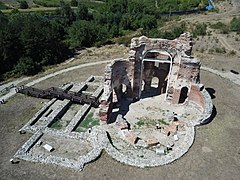





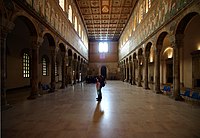




![Ruins of the 10th-century Church of Achillius of Larissa, on the eponymous island of Agios Achilleios, Mikra Prespa, a typical basilica church[68]](https://upload.wikimedia.org/wikipedia/commons/thumb/f/f9/%CE%92%CE%B1%CF%83%CE%B9%CE%BB%CE%B9%CE%BA%CE%AE_%CE%91%CE%B3%CE%AF%CE%BF%CF%85_%CE%91%CF%87%CE%B9%CE%BB%CE%BB%CE%B5%CE%AF%CE%BF%CF%85.jpg/200px-%CE%92%CE%B1%CF%83%CE%B9%CE%BB%CE%B9%CE%BA%CE%AE_%CE%91%CE%B3%CE%AF%CE%BF%CF%85_%CE%91%CF%87%CE%B9%CE%BB%CE%BB%CE%B5%CE%AF%CE%BF%CF%85.jpg)


